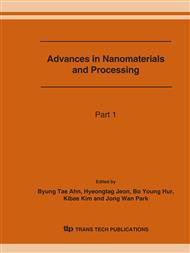p.1557
p.1561
p.1565
p.1569
p.1573
p.1577
p.1581
p.1585
p.1589
The Sliding Wear Behavior of Titanium Carbide Dispersion-Reinforced Steel
Abstract:
The tribological behavior of TiC-based metal matrix composites was investigated via measuring counterpart weight. The composites were prepared using powder metallurgy technique. Wear of counterpart by the composites varying from 35 to 45 % by volume Titanium carbide were observed over a load ranges of 9.81 to 49.05 N and sliding velocities of 2.0, 2.2, 2.4, 2.6, 2.8 and 3.0 m/sec. Detailed wear track micro-graphy was done to verify the effect of sliding condition on wear mechanism. Observations indicate that wear rate of counterpart increases with the increase in load and the sliding velocity and discontinuous wear rate change occurs at a certain load.
Info:
Periodical:
Pages:
1573-1576
Citation:
Online since:
June 2007
Authors:
Price:
Сopyright:
© 2007 Trans Tech Publications Ltd. All Rights Reserved
Share:
Citation:


